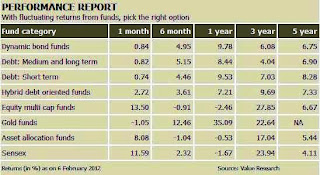A number of fund houses prepare to launch these open-ended schemes
Investors in debt funds are in a bind. While there are indications that Reserve Bank of India is likely to cut indicative rates, there is uncertainty on when it will happen and by how much.
The existing rates of interest — eight per cent plus — is good. But if rates fall, it could be better for investors due to rise in prices. To take advantage of this uncertainty, a number of fund houses are lining up to launch open-ended dynamic bond funds.
Three fund houses — IDBI Mutual Fund, Pramerica MF and Union KBC — have already done so. Two more, Daiwa MF and Principal MF, have filed offer documents with the regulator, the Securities and Exchange Board of India (Sebi).
Dynamic bond funds, as the name suggests, are able to take advantage of rate cuts or rises by altering their portfolio. But here lies the danger as well.
Sometimes, fund managers can get their churning right or it can go haywire as well. So, returns can widely fluctuate.
In the one-year category, return on dynamic funds is 9.78 per cent. However, the best performing fund — SBI Dynamic Bond — has given a the return of 12.99 per cent, while the worst-performing — Tata Dynamic Bond A & B — have given a return of 7.51 and 7.52 per cent, respectively.
"The debt fund track record of the fund manager and the fund house plays a very important role in deciding which dynamic bond fund one should choose. The investment process and philosophy should be looked at," explains Mahendra Jajoo, director and CIO (fixed income) at Pramerica MF. Investors need to check the track record before taking a call.
The trick in these funds lies in being made to predict the rate fluctuations correctly and change the portfolio. "When the interest rate is rising, bond prices fall and the fund manager should be able to decrease the duration of the bond; short-term bonds face a lower impact. And, when the interest rate is falling, they should be able to increase the duration of the bond," says Gautam Kaul, fund manager, IDBI MF.
The taxation on these funds is computed like any other debt scheme. Long-term capital gains tax is calculated at 10 per cent with indexation and 20 per cent without it. In the short term, capital gains will be added to your income and taxed, according to slab.
But since the risk involved with investing in these funds is not very high, Suresh Sadagopan, a certified financial planner,says one can allocate 20-40 per cent of the debt portfolio in these funds. "From a 6-18 month perspective, these funds are far more tax-efficient and will give you better returns than a bank fixed deposit, a national savings certificate or PPF. They are less risky than corporate bonds as well."
In terms of cost, they are comparable. For dynamic bond funds, the expense ratio can be anywhere between 0.7 per cent and one per cent, higher than most short-term debt funds. However, the expense ratio is comparable to income funds (higher tenure debt funds).
The exit loads vary between fund houses. It is around 0.5 per cent and for six months to one year. Some fund houses do not charge exit loads.
--
___________________________________________________________________________________
'I made my money by selling too soon.'
Website: http://indianmutualfund.co.cc/
Blog:http://indianmutualfund.wordpress.com/
___________________________________________________________________________________

No comments:
Post a Comment